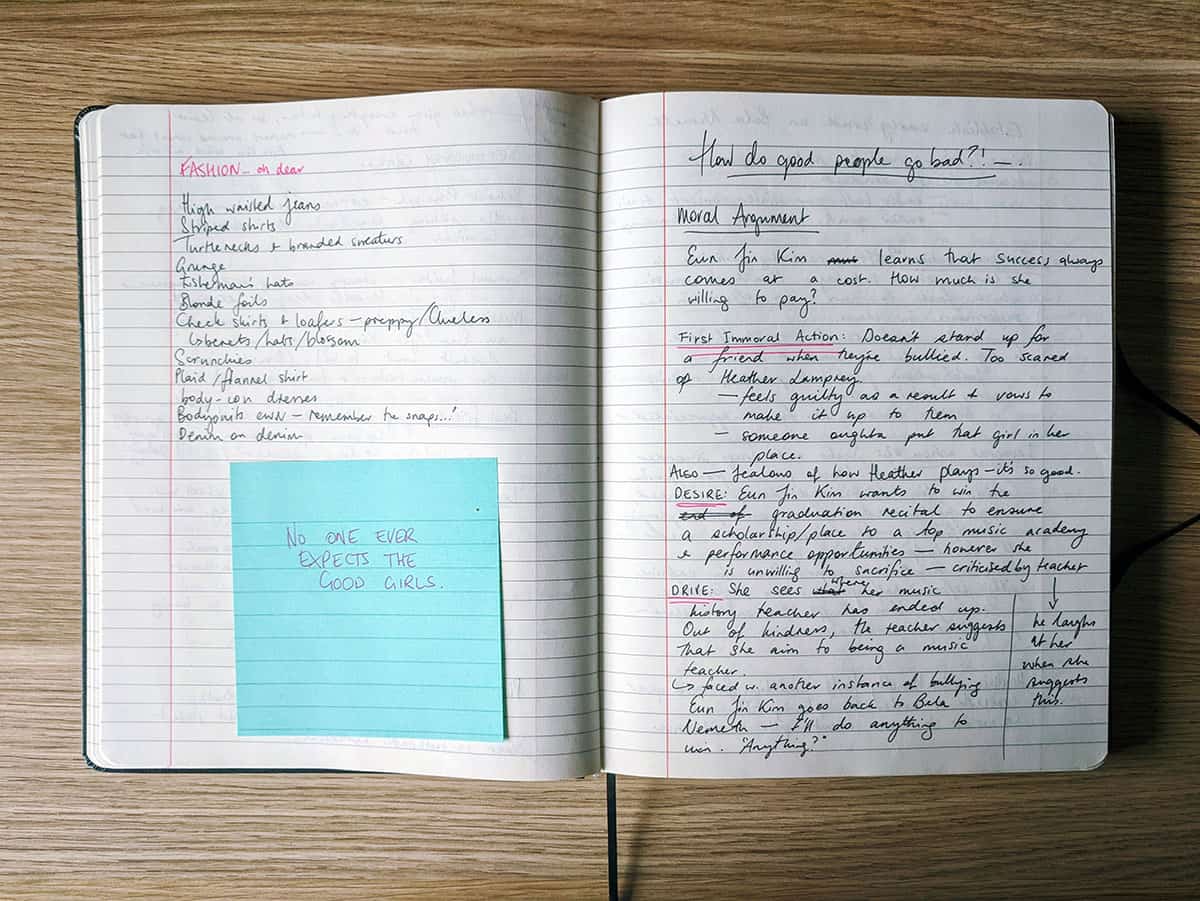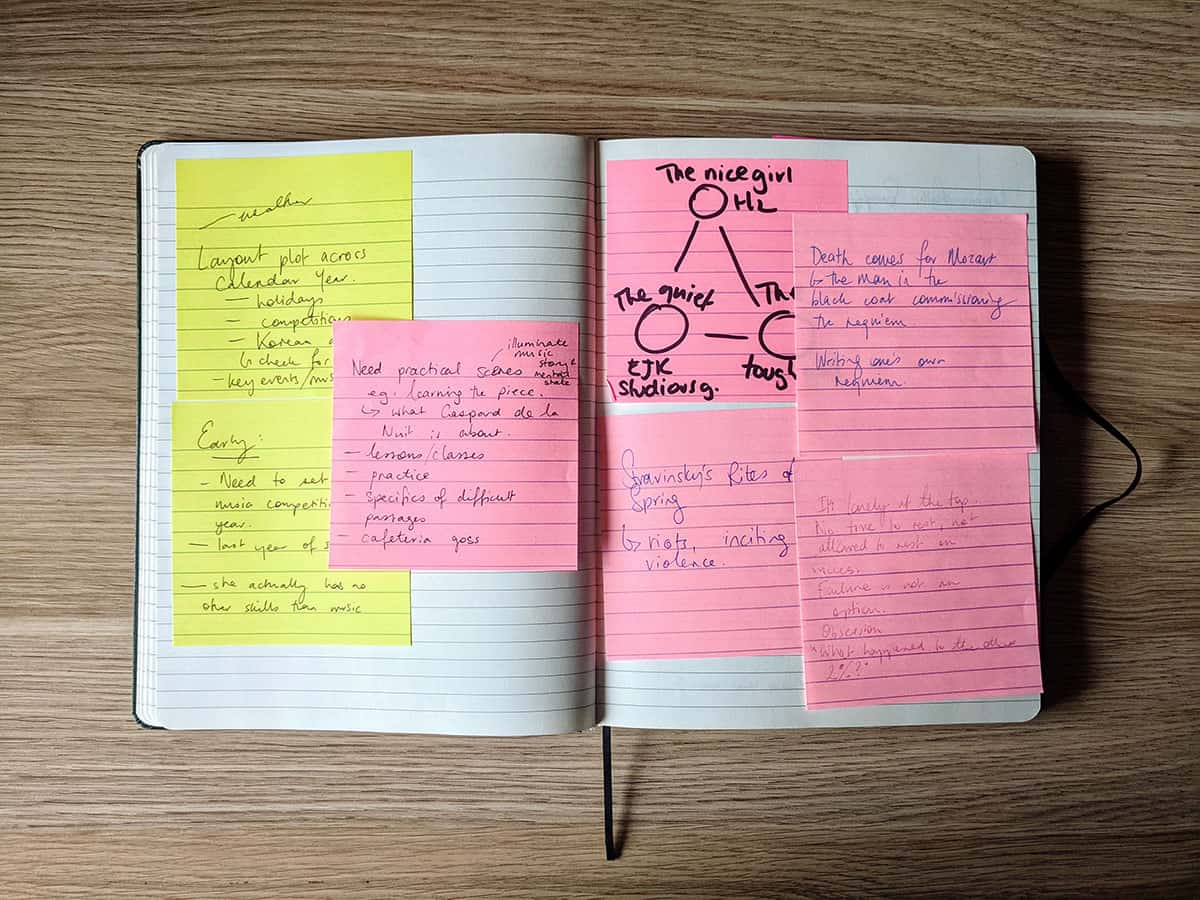How do you keep track of your creative writing ideas? I’m sure you’ve seen those beautiful bullet journals on Instagram with perfectly scripted writing and matching illustrations. 😍
There’s an expectation when we write creatively that our note-taking process has to be perfect as well. I don’t know about you, but that pesky perfectionism destroys my creativity and sucks my time.
Ideas are messy. Drafts are messy. Life is messy.
For a long time I would write all my book ideas on ephemera; napkins, post-it notes, old envelopes. And funnily enough, these scraps all ended up in random places where I could never find them. Try looking through three different notebooks to find the ending of a book you’ve written (I never found the ending and had to rewrite it).
Way back when I lived in Sydney, my mentor Jan Cornall got me onto the idea of scrapbooking for writing. I’ve always loved papercraft and scrapbooking anyway, so this was a way of putting ideas down in creative ways.
Fast forward several years, and I’m still doing my own version of scrapbooking, in what I like to call a dump book.
What is a dump book you may ask? Exactly that. A single place where you dump all your ideas, your scraps of paper and post-it notes.

It’s not a pretty book. It’s a book that gets used, gets dirty and doesn’t care if your handwriting is terrible.
A dump book is the unhinged cousin of bullet journaling.
I’ll share some of my own dump books here – although I’ve had to find pages that don’t have spoilers!
How a dump book works
You need one notebook for each topic or book. I used to keep all my notes for various topics – from my shopping lists to the latest novel – in one notebook. Big mistake.
I’ve now separated out my notebooks by general topic, with a separate notebook for every major writing project.
For example, my current notebooks
- Kat Clay business/writing ideas notebook
- Photography business notebook
- GotN (latest novel) notebook
- Victorianoir notebook
- The James Ellroy Language Appreciation Book for Klassy Dames (dump book for crime vocabulary)
- Handbag notebook (small book for notes on the run)
- Weekly planner (not a dump book, but helpful)
These don’t have to be pretty notebooks. In fact, the dump book for my latest novel project is a standard large lined book from Officeworks, which cost me all of $10.

I’ve also used Leuchtturm dot grid journals for my business notebooks, and recently purchased Nuuna dot grid journals, which I like a bit more than the Leuchtturm books simply for the extra size and paper quality.
I try to match up the notebook covers to the project for fun – writing a cyberpunk novel? Holographic cover.
But you don’t need anything fancy. I only recommend getting a notebook larger than A5 for any novel writing plans, because I fill them up with heaps of post-its and scraps of paper when I’m plotting a book.
This is not meant to be pretty

The biggest thing you need to get over is the perfectionism of keeping a notebook.
I used to think I needed a special pen and a certain type of paper to write.
I got over this by writing my first novel on A5 reporter pads from the supermarket with a pencil.
Same goes for the dump book. You can have systems, sure, you can spend time making it pretty with washi tape (I love washi tape), but when it comes down to it, the desire to make your notebook pretty shouldn’t get in the way of actually writing notes. It’s there to capture your ideas.
What to put in your dump book

When I’m writing a novel, I’ll put everything in the dump book. I’ll use it to plan out character motivations and the story world. I’ll glue in postcards and images that inspire the book. Here are some of the things I include:
- Plot cards
- Character charts
- Timelines
- Postcards
- Inspiring imagery
- Editing notes
- Random scraps and ideas
- Questions
- Quotes
- Research
- Notes on storytelling
That way it’s all in one place and I can go back to refer to it whenever I want. When the novel is finished, I archive the dump book into a box with my bajillion other notebooks.
The good thing about using separate notebooks is that if the project is finished, I can put that notebook away. If I need it again, it’s easy to pull out.
Hang on, isn’t the dump book just another word for notebook…?
Okay in writing this, I have thought that this might just be the way I use my notebooks. But I like calling them a dump book – a notebook implies it is just for written notes. Whereas a dump book means EVERYTHING goes in there, no exceptions.
I love sharing insights into my planning process, and I hope it helps inspire you to be creative and keep all your ideas in one place. I’m really interested to hear from other writers how they keep their projects organised. Is your notebook super beautiful? Or is it, like mine, a dog’s breakfast? Please share your processes in the comments below.

Share your thoughts